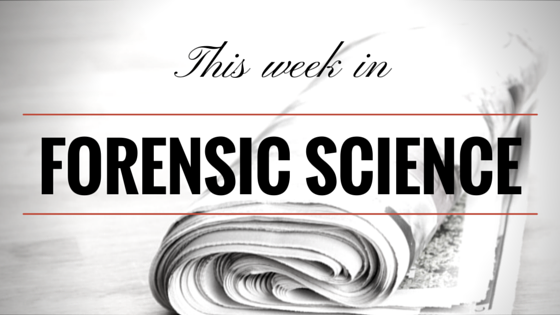No one has hours to scour the papers to keep up with the latest news, so we’ve curated the top news stories in the field of Forensic Science for this week. Here’s what you need to know to get out the door!
Tennessee Bill Would Boost Use of NamUs (Forensic Magazine – 4/21/2017)
But there is a limiting factor. While most unidentified bodies are meticulously added into the database, it’s the other side of the equation—the missing—who are often left out of the database. Only a fraction of people who disappear are ever added to NamUs, said J. Todd Matthews, the director of case management and communications for the organization.
Gov. Eric Holcomb Signs DNA Collection Bill (IndyStar – 4/21/2017)
Gov. Eric Holcomb signed into law Friday a bill that allows the collection of DNA from those arrested on felony charges.
Governor Announces Oklahoma Task Force on Sexual Assault Forensic Evidence Backlog (Red Dirt Report – 4/24/2017)
Oklahoma Gov. Mary Fallin announced the formation of the Oklahoma Task Force on Sexual Assault Forensic Evidence Monday to explore the backlog of sexual assault forensic evidence kits, commonly known as rape kits, in the criminal justice system in Oklahoma.
DNA Breakthrough for Unknown Soldiers (Illawarra Mercury – 4/24/2017)
- The chances of identifying some of the 35,000 Australian soldiers who lie unknown in foreign fields are a step closer with a dramatic DNA breakthrough by Sydney scientists.
Frozen in Time: DNA May ID Sailors Looking for Northwest Passage in 1845 (LiveScience – 4/24/2017)
Scientists have extracted DNA from the skeletal remains of several 19th-century sailors who died during the ill-fated Franklin Expedition, whose goal was to navigate the fabled Northwest Passage.
Some 8,000 Nevada Inmates Are Not in CODIS – How Many Cold Cases Will Their DNA Solve? (Forensic Magazine – 4/25/2017)
Some 8,000 long-term inmates behind bars in Nevada have been convicted of the most depraved crimes imaginable. Some have killed and robbed, others have raped and stolen. Almost all have ruined lives other than their own.
Pollen Forensics Could Help Track Down Criminals (WSB-TV – 4/25/2017)
It’s springtime in north Georgia and pollen is everywhere. Even when the initial spring burst of pollen fades, there’s usually at least some trace of pollen around most of the year.
Dr. Berry Brosi, an environmental sciences professor at Emory University, said that’s what makes it a great way to track the movements of people and things.
Murdered Woman’s Fitbit Log Used to Charge Husband (Forensic Magazine – 4/26/2017)
In this case, police obtained a search warrant for Connie Dabate’s Fitbit data, which registered movement more than an hour after her husband alleged an intruder shot her.
First Americans May Have Been Neanderthals 130,000 Years Ago (New Scientist – 4/26/2017)
An extraordinary chapter has just been added to the story of the First Americans. Finds at a site in California suggest that the New World might have first been reached at least 130,000 years ago – more than 100,000 years earlier than conventionally thought.
Florida Apologizes for ‘Shameful Past’ at Dozier School for Boys (Forensic Magazine – 4/26/2017)
- Today, Florida apologized to some of the many victims—some of whom were in the audience watching in the state legislature.
No Bones About It: Scientists Recover Ancient DNA From Cave Dirt (New York Times – 4/27/2017)
Sifting through teaspoons of clay and sand scraped from the floors of caves, German researchers have managed to isolate ancient human DNA — without turning up a single bone.
Out of the Past: DNA ID’s Pearl Harbor Victim (Auburn Journal – 4/27/2017)
Breakthroughs in DNA technology have been able to identify bones that had rested anonymously the past 75 years with Pearl Harbor’s grave of ‘unknowns.’
And that has led to plans by the U.S. Navy for a re-burial in an Auburn cemetery of Coxswain Verne Knipp, a 22-year-old sailor from Salida, Colo. who died during the 1941 ‘day that will forever live in infamy.”
21,587 Reasons to Fix Forensic Science (New York Times – 4/27/2017)
Last week, prosecutors in Massachusetts agreed to throw out more than 20,000 drug convictions dating back to 2003 because a single crime lab chemist, Annie Dookhan, admitted in 2012 that she had doctored or completely made up drug test results for years.
Europe’s Famed Bog Bodies Are Starting to Reveal Their Secrets (Smithsonian – 5/2017)
High-tech tools divulge new information about the mysterious and violent fates met by these corpses
WOULD YOU LIKE TO SEE MORE ARTICLES LIKE THIS? SUBSCRIBE TO THE ISHI BLOG BELOW!
SUBSCRIBE NOW!


